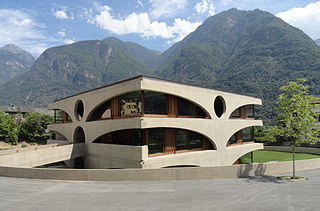
Bruno Julius Florian Taut was a renowned German architect, urban planner and author of Prussian Lithuanian heritage. He was active during the Weimar period and is known for his theoretical works as well as his building designs.

Theodor Fischer was a German architect and teacher.

Expressionist architecture was an architectural movement in Europe during the first decades of the 20th century in parallel with the expressionist visual and performing arts that especially developed and dominated in Germany. Brick Expressionism is a special variant of this movement in western and northern Germany, as well as in the Netherlands.

Adolf Bruno Behne was a German critic, art historian, architectural writer, and artistic activist. He was one of the leaders of the Avant Garde in the Weimar Republic.
The Arbeitsrat für Kunst was a union of architects, painters, sculptors and art writers, who were based in Berlin from 1918 to 1921. It developed as a response to the Workers and Soldiers councils and was dedicated to bringing current developments and tendencies in architecture and art to a broader population.
Dietmar Eberle is an Austrian architect. Winner of over 150 national and international competitions, he has been a teacher in several universities in North America and Europe. Since 1999 he has been Professor at the ETH Zurich, becoming the Dean of the School of Architecture within the same university between 2003 and 2005. He has also been header of the Center of Housing and Sustainable Urban Development at the ETH Zurich.

Valerio Olgiati is a Swiss architect. He initially studied architecture at ETH Zurich, a public research university in Zurich, Switzerland, after which he lived in Switzerland, followed by Los Angeles in the United States.

Vittorio Magnago Lampugnani is an architect, architectural theorist and architectural historian as well as a professor emeritus for the History of Urban Design at the Swiss Federal Institute of Technology Zurich. He practices and promotes a formally disciplined, timelessly classic, and aesthetically sustainable form of architecture, one without modernist or postmodernist extravagances. As an author and editor of several acclaimed works of architectural history and theory, his ideas are widely cited.

Bazon Brock is a German art theorist and critic, multi-media generalist and artist. He is considered a member of Fluxus. He was a professor of aesthetics at the Hochschule für bildende Künste Hamburg, the University of Applied Arts Vienna and the University of Wuppertal.

Andreas Urs Sommer is a German philosopher of Swiss origin. He specializes in the history of philosophy and its theory, ethics, philosophy of religion, and Skepticism. His historical studies center on the philosophy of Enlightenment and Nietzsche, but they also deal with Kant, Max Weber, Pierre Bayle, Jonathan Edwards, and others.
Rudolf Olgiati was a Swiss architect. Olgiati is known for his work with Alfred Werner Maurer on the French Riviera, and has had some of his more notable work exhibited in the 1977 ETH Zürich.

Matthias Böttger is a German architect and curator.
E2A Architects is an architecture firm based in Zürich, Switzerland. The office is led by Piet Eckert and Wim Eckert who founded E2A Architects in 2001.
HHF Architects is an architectural practice established in Basel, Switzerland by Tilo Herlach, Simon Hartmann, and Simon Frommenwiler, in 2003.

Christian Kerez is a Swiss architect, architectural photographer and a university professor.
Ákos Moravánszky, is a Swiss-Hungarian architect, theorist, historian and Adjunct Professor Emeritus of Architectural Theory at the Institute for the History and Theory of Architecture at the Swiss Federal Institute of Technology in Zurich. Moravánszky is regarded as one of the world's leading architecture historians of Central European architecture.

Marc Kocher is a Swiss architect, known for his residential building designs.

Raphael Zuber is a Swiss architect.
The Swiss Architectural Award is an international architecture award.












